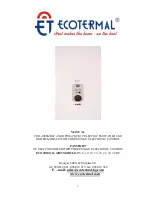
12
• D2665 (PVC-DWV)
• D2241 (SDR-21 and SDR-26 PVC)
• D2661 (ABS-DWV)
• F628 (schedule-40 ABS).
Pipe cement and primer must conform to ASTM
standards D2564 (PVC) or D2235 (ABS).
In Canada construct all combustion air and vent
pipes for this unit of CSA or ULC certified sched-
ule-40 CPVC, schedule-40 PVC, PVC-DWV or
ABS-DWV pipe and pipe cement. SDR pipe is
NOT approved in Canada.
3. Combustion air and vent piping connections
on boiler are 2”, but must increase to 3”. Due to
potential for flue gas temperatures over 155°F,
the first 5 feet of vent pipe must be CPVC (fur-
nished), the remaining vent pipe can be PVC.
If any elbows are employed within the first 2 ½’
feet of vent, they must be CPVC. Two 30” pieces
of 2” CPVC pipe and one 2” CPVC coupling are
furnished with the boiler.
(Figure 11)
NOTE:
The exhaust transition from 2” pipe to 3” pipe must
be made in a vertical run. (Transition pieces not included.)
The length of pipe is counted from the boiler jack-
et (air intake pipe) or from vent tee (vent pipe).
The first five feet of “Total Equivalent Length” of
vent pipe must be CPVC.
Reduce the maximum vent length 5 feet per
each additional elbow.
4. Combustion air and vent piping to be pitched
back to boiler at minimum ¼” per foot from intake
and vent terminals so that all moisture in com-
bustion air and vent piping drains to boiler. Pipes
must be pitched continuously with no sags or low
spots where moisture can accumulate and block
the flow of air or flue gas. Combustion air and
vent pipes must be airtight and watertight.
5. Consideration for the following should be used
when determining an appropriate location for ter-
mination of combustion air and vent piping:
• Comply with all clearances required as
stated in paragraph 6 (below)
• Termination should be positioned where
vent vapors will not damage plants/shrubs,
air conditioning equipment, or siding on the
house.
• Termination should be positioned so that
it will not be effected by wind eddy, air born
leaves, snow, or recirculated flue gases.
• Termination should be positioned where it
will not be subjected to potential damage by
foreign objects, such as stones, balls, etc.
• Termination should be positioned where
vent vapors are not objectionable.
• Put vent on a wall away from the prevailing
winter wind. Locate or guard the vent to pre-
vent accidental contact with people or pets.
• Terminate the vent above normal snow-
line. Avoid locations where snow may drift
and block the vent. Ice or snow may cause
the boiler to shut down if the vent becomes
obstructed.
• Under certain conditions, flue gas will con-
dense, forming moisture, and may be corro-
sive. In such cases, steps should be taken
to prevent building materials at the vent from
being damaged by exhaust of flue gas.
6. The venting system shall terminate at least 3
feet above any forced air inlet (except the boiler’s
combustion air inlet) within 10 feet. The venting
system shall terminate at least 12 inches from
any air opening into any building. The bottom
of the vent shall be located at least 12 inches
3 in. Pipe
Minimum Venting
3 in. Pipe
Maximum Venting
6 ft. in length plus
four (4) 90° elbows
60 ft. in length and up
to four (4) 90° elbows
COMBUSTION AIR AND VENT PIPING
Figure 11
5
'
3 INC H INT AK E AND
E XHAUS T T E R MINAT IONS
E XHAUS T T E E
(F UR NIS HE D)
2˝ (50.8MM) C OMB US T ION AIR
INT AK E P IP ING
2˝ (50.8MM) C P V C C OUP LING
(F UR NIS HE D)
2˝ (50.8MM) C P V C V E NT P IP ING
(F UR NIS HE D & R E QUIR E D)
A04177
INS T ALL F IE LD S UP P LIE D
2˝ B Y 3˝ T R ANS IT ION IN
T HE V E R T IC AL P OS IT ION ONLY
NOT IN
HOR IZONAL
S E C T ION













































